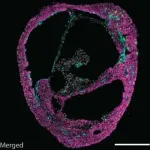(Press-News.org) For many engineers and scientists, nature is the world's greatest muse. They seek to better understand natural processes that have evolved over millions of years, mimic them in ways that can benefit society and sometimes even improve on them.
An international, interdisciplinary team of researchers that includes engineers from The University of Austin has found a way to replicate a natural process that moves water between cells, with a goal of improving how we filter out salt and other elements and molecules to create clean water while consuming less energy.
In a new paper published today in Nature Nanotechnology, researchers created a molecule-sized water transport channel that can carry water between cells while excluding protons and undesired molecules. These channels mimic the water transport functions of proteins in our bodies known as aquaporins. In our cells, uncontrolled transport of protons alongside water can be harmful because they can change the pH of cells, potentially disrupting or killing them.
This is the first instance of an artificial nanometer-sized channel that can truly emulate the key water transport features of these biological water channels. And it could improve the ability of membranes to efficiently filter out unwanted molecules and elements, while speeding up water transport, making it cheaper to create a clean supply.
"It copies nature, but it does so by breaking the rules nature has established," said Manish Kumar, an assistant professor in the Cockrell School of Engineering's Department of Civil, Architectural and Environmental Engineering. "These channels facilitate speedy transport of molecules you want, like water, and block those you don't want, like salt."
The research team's artificial water channels can perform the same functions as aquaporins, which are crucial at a larger level for desalination, water purification and other processes for separating molecules. And they do so while transporting water 2.5 times faster compared to aquaporins.
The artificial channels are three nanometers in width by three nanometers in length. If densely packed into the correct size membrane, the channels can pass roughly 80 kilograms of water per second per square meter of membrane, while rejecting salts and protons at rates much higher than current commercial desalination membranes are capable of.
"These artificial channels in essence solve the critical technical challenges of only allowing water molecules to pass while excluding other solutes like salt and protons," said professor Huaqiang Zeng of Department of Chemistry at Hainan University and the Institute of Advanced Synthesis at Northwestern Polytechnical University in China. "Their extraordinary water transportation speed and the fact that these channels allow for simpler membrane fabrication suggest they will become a crucial component of next-generation membranes for producing clean water to address severe scarcity facing human beings in this century."
Aquaporin-based channels are so small that they only allow a single molecule of water through at a time, like a single-lane road. A unique structural feature in these new channels is a series of folds in the channels that create additional "lanes," so to speak, allowing water molecules to be transported faster.
"You're going from a country road to a highway in terms of water transport speed, while still keeping out other things by putting little bumps in the road," said Aleksei Aksimentiev, a professor of biological physics at the University of Illinois at Urbana-Champaign who collaborated on the research.
Kumar took a class taught by Aksimentiev on the physics of nanomachines while studying for his Ph.D. in environmental engineering at the University of Illinois. The course, he said, was about as challenging as it comes, and he still refers back to his notes from the class years later.
They worked together on a paper when Kumar was a student. And then when he became a professor, Aksimentiev helped him with simulation work on another paper. For years now, they have been collaborating on the study of water transport channels.
The interdisciplinary team features faculty and researchers from around the world in physics, chemical engineering, pharmacology and more. Researchers come from UT Austin, University of Illinois, Harvard Medical School, Hainan University and Northwestern Polytechnical University in China and NanoBio Lab in Singapore.
Zeng is the corresponding author on the paper. Kumar led the testing portion of the project and Aksimentiev led the simulation work.
Earlier this year, Kumar teamed with Penn State University researchers on a discovery that shed new light on how traditional water desalination membranes work. They found that uniformity throughout the membrane speeds up transporting water and improves the process of filtering out salt.
This new work, Kumar says, takes that concept to another level. These channels can only be one size to fit the desired water molecules through while squeezing out other unwanted molecules.
Going forward, the team plans to use these artificial water channels to fabricate next-generation reverse-osmosis membranes to convert seawater to drinkable water.
INFORMATION:
Self-organizing heart organoids developed at IMBA - Institute of Molecular Biotechnology of the Austrian Academy of Sciences - are also effective injury- and in vitro congenital disease models. These "cardioids" may revolutionize research into cardiovascular disorders and malformations of the heart. The results are published in the journal Cell.
About 18 million people die each year from cardiovascular diseases, making them the leading cause of fatalities globally. Moreover, the most prevalent birth defects in children pertain to the heart. Currently, a major bottleneck in understanding human heart malformations and developing regenerative therapies are missing human physiological models of the heart.
The research group of Sasha Mendjan established cardioids ...
NEW YORK, NY (May 20, 2021)--The immune nature of kidney cancer stands out when compared to other cancers: More immune cells infiltrate kidney cancers than most other solid tumors, and kidney cancer is one of the most responsive malignancies to today's immunotherapy regimens.
But despite treatment, many patients with clear cell renal carcinoma--the most common type of kidney cancer--eventually relapse and develop incurable metastatic disease.
A new study shows that the presence of a rare and previously unknown type of immune cell in kidney tumors can predict which patients are likely to have cancer recur after surgery. These cells could even ...
We observe water vapor condensing into liquid droplets on a daily basis, be it as dew drops on leaves or as droplets on the lid of a cooking pot. Since the work of Dutch physicist J.D. van der Waals in the 19th century, condensation has been understood to result from attractive forces between the molecules of a fluid.
Now, an international team of researchers has discovered a new mechanism of condensation: Even if they don't attract each other, self-propelled particles can condense by turning toward dense regions, where they accumulate. The study was published in Nature Physics.
"It's like if cars steered toward crowded areas and made the crowd even bigger," explained Steve Granick, director of the IBS Center for Soft and Living ...
Antiretroviral therapy, the common approach in the treatment of HIV, halts replication of the virus and has saved the lives of millions of people. However, for patients the drug cocktail becomes a lifetime necessity because they continue to harbor latent HIV in a small number of immune system cells. In the absence of treatment, HIV can again replicate and rebound into full blown AIDs.
A new study, however, suggests that addition of a single small molecule can rip away the cloak that shields those cells containing HIV and make them susceptible the patient's own antibodies that otherwise are not normally of much use against HIV.
For the study, a team of researchers ...
HOUSTON - Researchers at The University of Texas MD Anderson Cancer Center have developed a first-of-its-kind artificial intelligence (AI)-based tool that can accurately identify rare groups of biologically important cells from single-cell datasets, which often contain gene or protein expression data from thousands of cells. The research was published today in Nature Computational Science.
This computational tool, called SCMER (Single-Cell Manifold presERving feature selection), can help researchers sort through the noise of complex datasets to study cells that would likely not be identifiable otherwise.
SCMER may be used broadly for many applications in oncology and beyond, explained senior author Ken Chen, Ph.D., associate professor of Bioinformatics ...
A national study from researchers at Michigan Medicine found that nearly 3% of insured U.S. adults under 65 take medications that weaken their immune systems.
The findings, published in JAMA Network Open, are based on data from over 3 million patients with private insurance. They focus on patients' use of immunosuppressive drugs, including chemotherapy medications and steroids such as prednisone.
The analysis reveals nearly 90,000 people met the study criteria for drug-induced immunosuppression that may elevate risk for severe COVID-19 symptoms and hospitalization ...
Young children who practice visual working memory and reasoning tasks improve their math skills more than children who focus on spatial rotation exercises, according to a large study by researchers at Karolinska Institutet in Sweden. The findings support the notion that training spatial cognition can enhance academic performance and that when it comes to math, the type of training matters. The study is published in the journal Nature Human Behaviour.
"In this large, randomized study we found that when it comes to enhancing mathematical learning in young children, the type of cognitive training performed plays a significant role," says corresponding author Torkel Klingberg, professor in the Department of Neuroscience, Karolinska Institutet. "It is an important finding because it provides ...
A particular type of dendritic cell is responsible for the tissue damage that occurs in non-alcoholic steatohepatits (NASH) in mice and humans. The dendritic cells cause aggressive, proinflammatory behavior in T cells, as now discovered by researchers from the German Cancer Research Center (DKFZ) in collaboration with colleagues from Israeli research institutes. Blocking these dendritic cells alleviates symptoms in mice. This type of approach might also prevent the development of serious liver damage in NASH patients.
Obesity is extremely widespread in the Western world, and 90 percent of those affected show signs of fatty degeneration of the liver. If they maintain an unhealthy lifestyle ...
Solar geoengineering -- putting aerosols into the atmosphere to reflect sunlight and reduce global warming -- is not a fix-all for climate change but it could be one of several tools to manage climate risks. A growing body of research has explored the ability of solar geoengineering to reduce physical climate changes. But much less is known about how solar geoengineering could affect the ecosystem and, particularly, agriculture.
Now, research from the Harvard John A. Paulson School of Engineering and Applied Sciences (SEAS) finds that solar geoengineering may be surprisingly effective in alleviating some of the worst impacts of ...
CHAPEL HILL, NC - American politics can be stressful and confrontational, which can lead to anger. The combination of intense stress and negative emotions can trigger potentially fatal cardiovascular events in people who are susceptible to these health issues. But the direct link between a stressful political election and an increase in cardiac events hadn't been established, until now. A new study in the Journal of the American Heart Association is the first to show that exposure to a stressful political election is strongly associated with an increase in potentially life-threatening cardiac events.
"This retrospective ...




